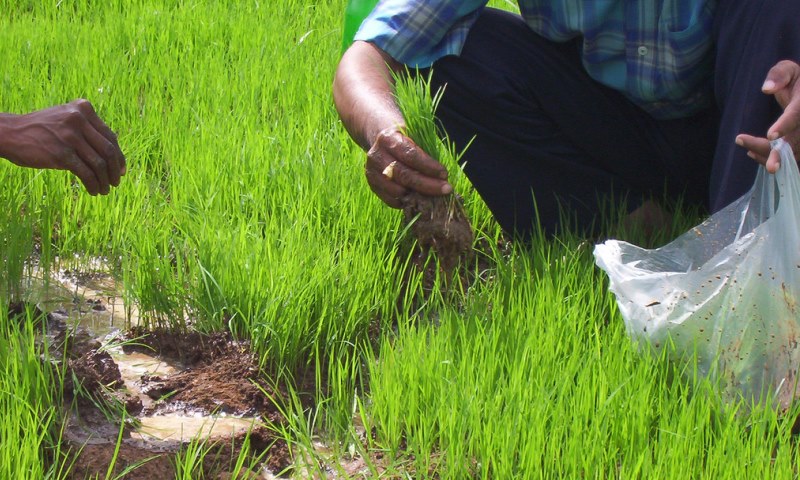Here Is How Climate Change Impacting Agriculture in India

Climate change can be defined and understood as significant changes in the global temperature, precipitation, wind patterns and other measures of climate that occur over more than three decades. The world is witnessing increasingly severe impacts of climate change since almost the last two hundred years. Climate change has some obvious impacts on the agriculture sector, and therefore on global food security.
According to the Government of India, while evidence of change in weather pattern over the country seems to be lacking, there have been large-scale reporting of extreme weather events in the recent past. These include extended dry periods, floods, hailstorms, cyclonic rains and winds etc. Most of these extreme weather events have caused damage to standing crops and and have ultimately led to poor yield of crops.
As per the India Meteorological Department and other related institutions, there have been significant changes in the rainfall pattern and extreme events in India. A direct impact of climate change being witnessed by the agricultural sector in India is that the spatial variability, intensity and frequency of extreme events like heavy rainfall have increased. Climate change related non-seasonal rains with hailstorm, cyclone etc. have affected almost all the states of India in the last three years.
Extreme Weather Events and Affected States (2015-2017)
Heavy Rainfall: Tamil Nadu, Andhra Pradesh, Assam, Gujarat, Madhya Pradesh, Manipur, Odisha, Rajasthan, West Bengal, Maharashtra, Uttarakhand, Bihar, Uttar Pradesh.
Hailstorm: Bihar, Gujarat, Madhya Pradesh, Maharashtra, Rajasthan, Haryana, Punjab, Uttar Pradesh, Uttarakhand, Himachal Pradesh, J&K, Telangana, Andhra Pradesh, Kerala, West Bengal, Odisha
Drought: Chhattisgarh, Karnataka, Jharkhand, Odisha, Madhya Pradesh, Maharashtra, Andhra Pradesh, Telangana, Rajasthan, Punjab, Haryana, Uttar Pradesh
Cyclone: Gujarat (2015), Tamil Nadu (Vardah, 2016), Kerala and Tamil Nadu (Ockhi, 2017)
States in red experienced extreme weather events for more than one year.
Disaster Assistance for Extreme Weather Related Damages
Agricultural crops have been significantly affected due to extreme weather related calamities in the recent past. The Central Government has been providing assistance to states that have suffered losses due to droughts and hailstorms shows. Data provided by the Government shows 11 states asked for a total financial assistance against droughts and hailstorm losses of Rs. 52765.22 crores in 2015-16. The Central Government approved an amount of Rs. 15537.74 crores in the same financial year.
During 2016-17, six states and Union Territories asked for a Central Government assistance against losses due to drought and hailstorm amounting to Rs. 54905.56 crores. The Central Government approved Rs. 5563.28 crores in this financial year. And during the 2017-18 financial year, six states asked for financial assistance against drought and hailstorm losses amounting to Rs. 15756.56 crores and the Central Government approved Rs. 2089.27 crores towards the same.
During the ongoing financial year (2018-19), as on 06 December 2018, the State Government of Andhra Pradesh, Karnataka, Maharashtra, Jharkhand, Gujarat and Rajasthan have already declared drought and have submitted Memorandum seeking financial assistance. The state Government of Odisha has also declared drought but has not yet submitted Memorandum seeking financial assistance. Floods are another challenge and the country has not yet fully recovered from the Kerala floods.
Adaptation Strategies for Managing Extreme Weather Events
The battle against climate change seems to be a losing one as there is now a global shift from working towards mitigating climate change, to finding strategies towards adapting to climate change. This seems to be the case here too, and the Government of India is now promoting strategies to adapt to these extreme weather events. The Government informs that the State Government is primarily responsible for taking necessary relief measures in the wake of natural calamities.
According to information provided by the Minister of State for Ministry of Agriculture & Farmers Welfare Shri Gajendra Singh Shekhawat in the Parliament of India, funds are available with the State Government in the form of State Disaster Response Fund (SDRF). Additional financial assistance, over and above SDRF can be provided from National Disaster Response Fund (NDRF) for natural calamities of severe nature and is approved on the basis of Memorandum received from State Government, in accordance with established procedure.
The Central Research Institute for Dryland Agriculture (CRIDA) of the Indian Council of Agricultural Research (ICAR) has also prepared district-wise contingency plan for 633 districts. Under this, the States are advised to use short duration, drought tolerant, alternate crops, flood/ water logged tolerant varieties besides use of new technologies on crop cultivation. In order to insulate farmers against the loss of crop due to natural calamities, the Government of India has also launched the Pradhan Mantri Fasal Bima Yojana (PMFBY) since April 2016.
Clearly, the impacts of rapidly increasing extreme weather patterns and a changing climate are now here to stay. It is no longer important to just fight the climate crisis, but also learn to live with and survive with it. Time for action on climate change is long gone. It is now time for action to survive along with climate change and that is certainly the greatest tragedy of our times.
Image by L. Tucker via Flickr.




One thought on “Here Is How Climate Change Impacting Agriculture in India”